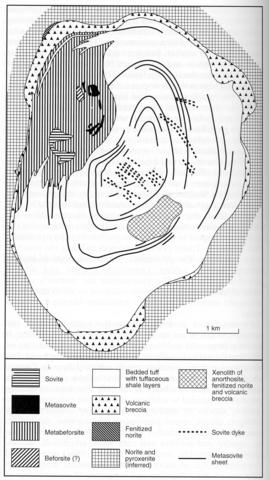stripes
The Goudini volcano is located within an ultrabasic body at the eastern margin of the Bushveld Complex. It is oval in outline, 4.5x3.5 km, but much of the geology is obscured by soil cover. The volcano can be divided into three main parts: an outer ring of volcanic breccias, a basin-shaped structure which occupies about 75% of the total area, including several different rock types but with bedded tuffs dominant, and an area in the northwest around Goudini Kop where outcrop is more extensive and carbonatites are the principal rock types. The volcanic breccias form a discontinuous ring reaching a width of 400-500 m in places but generally much less. The breccia consists of about 90% fragments of Bushveld norite in a finely granulated matrix, both fragments and matrix showing ample evidence of fenitization in the form of carbonate, cancrinite, aegirine and sodic amphibole replacing primary feldspar and pyroxene (Verwoerd, 1966b). The basin-shaped structure is defined by inward-dipping tuffaceous shales, bedded tuffs and conformable limestone layers with steeper dips near the margins. The basin is interpreted by Verwoerd (1967) as a caldera. The symmetry of the basin is modified by the carbonatite area in the northwest which appears to cause an indentation to the direction of strike in this area. The basin rocks are fine-grained, bedded, and in places cross-bedded sediments and in one borehole partly carbonated amygdaloidal lava has been encountered. The sediments are mostly a dense, black hornfelsic rock with some thin shale and grit bands. Norite blocks up to 0.5 m, and rarely up to 3 m, across occur in one area and possible lapilli have also been identified. The hornfelsic rock in section proves to consist of spots of carbonate and angular plagioclase fragments in a fine-grained matrix of chlorite, an opaque phase, a little biotite and minute feldspar laths or fragments. Some beds contain lenses of carbonate and albite with occasional aegirine, and these pass into continuous carbonate layers of about equal parts ankerite and albite with subordinate aegirine, rutile and limonite. Chemical analyses of these rocks are given by Verwoerd (1967) who concludes that they are re-worked bedded tuffs or tuffaceous shales which accumulated subaqueously. They were later partly replaced by albite, ankerite and aegirine. Large carbonate sheets, up to tens of metres in width, some examples of which can be followed for several kilometres, are conformable to the sediments and consist of calcite and, in some types, a little ankerite, apatite, albite and pyrite, while other varieties contain aegirine. Verwoerd (1967) considers that these sovites are metasomatic rocks that have replaced certain tuff layers, but he does refer to the possibility that they are cone-sheets or carbonate ash layers. The carbonatite area in the northwest of the complex encompasses a broad range of carbonatite types, eight of which were mapped (Verwoerd, 1967). The most widespread rock is a beforsite which is called 'metabeforsite' by Verwoerd, who concluded that it was generated by replacement of pyroclastic rocks. The beforsite is texturally, structurally and mineralogically variable but generally consists of ankerite, aegirine, albite and rutile. In one area this rock is characterised by uniformerly disseminated ramsayite and elsewhere sodic amphibole, barite, fluorite and anatase are present. Another type of beforsite has a nodular aspect, the nodules in section proving to consist of ankerite, albite and aegirine in a matrix of densely matted aegirine fibres, with sparse phlogopite in some varieties. Other carbonatite types distinguished include biotite metabeforsite, dykes of sovite, a dolomite rock, and carbonated breccias and lavas in which possible relict pillows or pahoehoe structures have been observed. Amongst the carbonatites veins, presumed to be hydrothermal, including dolomite-fluorite, pyrite-rutile-brookite and barite occur and silicified zones consist of quartz, iron oxides and barite. Verwoerd (1967) gives analyses of fenites, tuff and carbonatites and discusses in detail the probable geological history of the volcano. Nelson et al. (1988) have analyses of two carbonatites with trace element data, including REE, and Sr, Nd, Pb, O and C isotopes. Dawson et al. (1996) give analyses of calcite, dolomite, magnetite and forsterite.
DAWSON, J.B., STEELE, I.M., SMITH, J.V. and RIVERS, M.L. 1996. Minor and trace element chemistry of carbonates, apatites and magnetites in some African carbonatites. Mineralogical Magazine, 60: 415-25.NELSON, D.R., CHIVAS, A.R., CHAPPELL, B.W. and MCCULLOCH, M.T. 1988. Geochemical and isotopic systematics in carbonatites and implications for the evolution of ocean-island sources. Geochimica et Cosmochimica Acta, 52: 1-17.VERWOERD, W.J. 1966a. South African carbonatites and their probable mode of origin. Annale Universiteit van Stellenbosch, Series A 41: 145-53.VERWOERD, W.J. 1966b. Fenitization of basic igneous rocks. In O.F. Tuttle and J. Gittins (eds), Carbonatites. 295-308. John Wiley, New York.VERWOERD, W.J. 1967. The carbonatites of South Africa and South West Africa. Geological Survey of South Africa, Handbook, 6: 1-452

